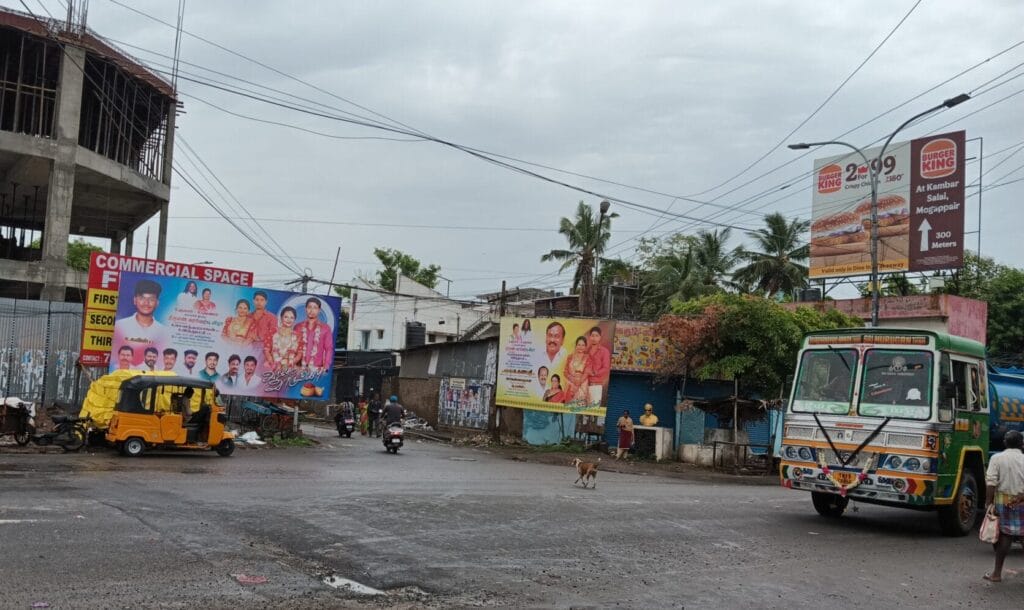Chennai is known for its rich cultural heritage, booming economy, and vibrant social life. However, the city faces a significant issue with the rampant proliferation of unauthorised advertising hoardings, or ‘flex’ banners. These banners are erected without permission from civic authorities. Despite existing regulations and penalties, this problem persists, leading to accidents and fatalities. This situation underscores the urgent need for stringent enforcement and increased public awareness.
What are ‘flex’ banners?
These banners are used for various purposes, including political campaigns, advertisements, religious events, and personal celebrations. Their low production cost and ease of use make them an attractive option for those seeking quick and inexpensive publicity. However, these banners pose significant risks to public safety and environmental health.
Read more: Why Chennai has not been able to get rid of illegal street hoardings
Firstly, these banners are often erected without proper structural support, making them susceptible to collapsing or being blown away by strong winds. When they fall, they can cause severe injuries or even fatalities to innocent pedestrians and motorists.
There have been a few tragic accidents in Chennai and other cities caused by illegal hoardings in the recent past. Most of these details are available on the internet. While many such incidents go unreported, here are a few notable ones:
- September 12 2019: Subhasri Ravi (23) passed away in Chennai after a hoarding erected on a road divider fell on her, while she was riding her scooter.
- January 31 2018: Thirty-year-old Rangaraj died in Coimbatore because of a hoarding crash
- October 2017: M Anitha, a college student passed away in Tirunelveli.
Effect on the environment
Secondly, there is also the environmental impact to consider. Flex banners are typically made from polyvinyl chloride (PVC), a non-biodegradable material that contributes to environmental pollution. According to the National Institutes of Health, PVC is considered as “the most environmentally damaging plastic and one of the most toxic substances for inhabitants of our planet.” The disposal of these banners is problematic, as they often end up in landfills or are burned, releasing harmful chlorine-based toxins into the air.

And lastly, the unchecked proliferation of flex banners mars the aesthetic appeal of Chennai. Historical landmarks, heritage buildings, and public spaces are often obscured by these advertisements, detracting from the city’s charm. This visual pollution not only affects residents’ quality of life but also hampers tourism, as visitors find the cluttered cityscape unappealing.
Legal history
Despite multiple orders passed by the Madras High Court and many government orders (GOs) from the Tamil Nadu government to prevent these banners, they continue to be put up unabated.
In 2021, after the death of a 12-year-old boy from Villupuram while attempting to set up an illegal flag post, the Madras High Court directed the state government to create rules to ban illegal flag posts, banners and flex boards.
Read more: No more flexibility over flexes: Will BBMP finally sort out advertising mess in city?
In December 2018, the Court directed political parties not to erect flex boards or hoardings that could inconvenience motorists and other commuters. Following a rebuke from the Court in September 2019, both the DMK and AIADMK pledged to comply with the laws regarding the placement of banners and cutouts.
Yet, these banners keep coming up. Here are the key reasons why:
- Corruption and bribery
- Political pressure
- Resource constraints of the civic authorities
- Lack of government will to tackle the menace.
A multi-pronged approach is necessary
Awareness campaigns must be conducted to educate the public about the dangers of the unauthorised flex banners and the legal implications when they are erected without permission. This can be done via social media, local newspapers and public service announcements.
In addition, involving the community is crucial to combat this menace. Residents can form neighbourhood watch groups to monitor and report unauthorised banners. Additionally, community leaders and influencers can play a significant role in advocating for a banner-free city.
The media can play a vital role in highlighting the dangers of unauthorised flex banners and holding authorities accountable for enforcement. Investigative journalism can expose instances of corruption and negligence, putting pressure on the Government to act.
Apart from taking action against offenders, the Greater Chennai Corporation (GCC) must take steps that could potentially benefit them as well. By properly identifying public hotspots, they can erect infrastructure for the display of the advertising banners and charge people to use them. This will improve the urban aesthetics and help curb this menace.
Despite regulations and penalties in place, the continued proliferation of these banners highlights the need for stricter enforcement and public awareness. Fatalities, such as Subhasri’s death, serve as stark reminders of the dangers posed by these unauthorised structures.
Addressing this issue requires a collaborative effort involving government authorities, law enforcement, community members, and the media. By working together, Chennai can reclaim its urban landscape and ensure the safety and well-being of its residents.
Residents can call the GCC number 1913 to report any illegal hoardings or flex banners in the city.
Well said!